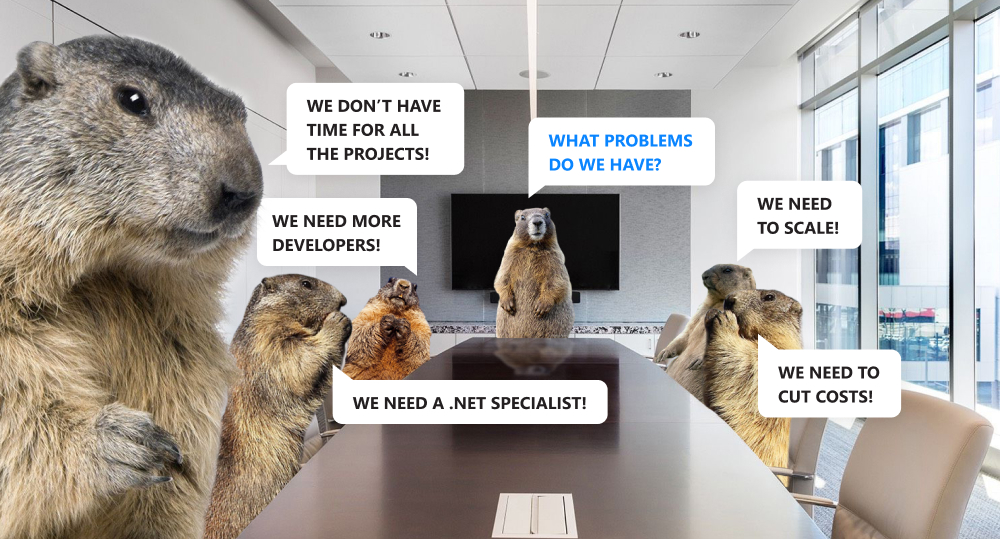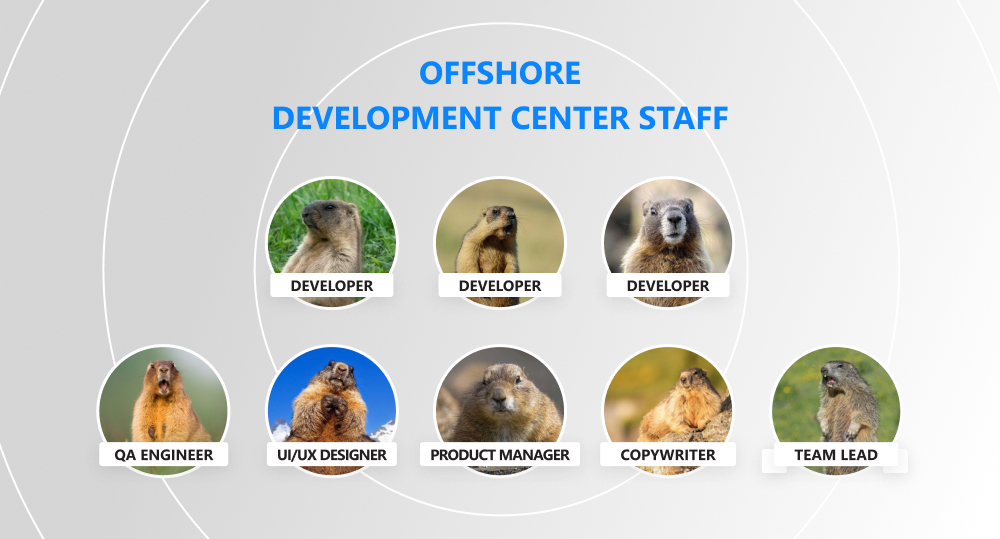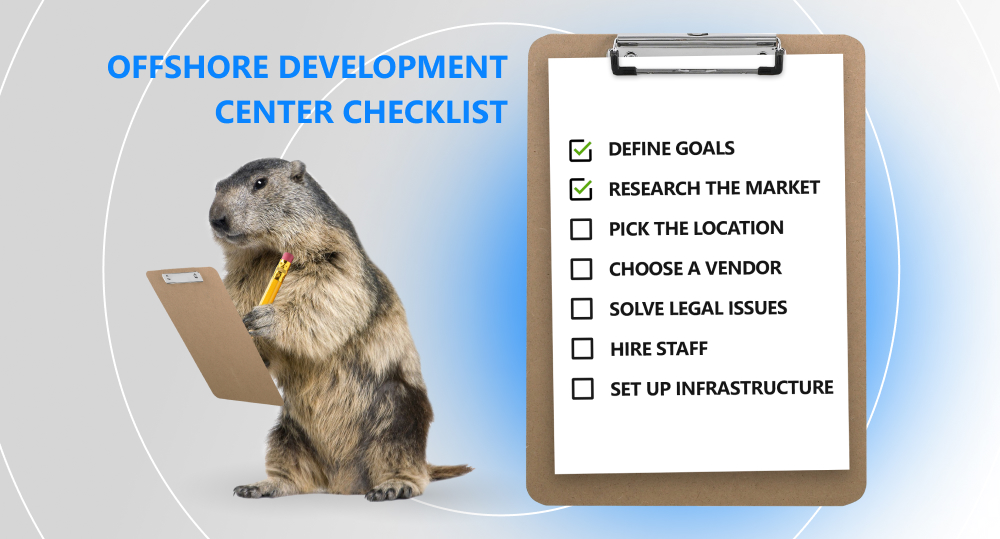A modern offshore development center is far from a tiny office somewhere in India or the Philippines, where 20+ developers work day and night to create your product. Today, these are high-end IT hubs where everything is perfectly organized. Wondering how to open such an office far from your homeland?
In this guide, we'll walk you through everything you need to know to set up an offshore development center (ODC), including the benefits, key considerations, and tips for building the right team. We'll also share some best practices for managing an ODC, so you can get the most out of your investment. Let's get started!
written by:
Alexander Arabey
Director of Business Development
Contents
What Is an ODC — Offshore Development Center?
Imagine a typical American software development company. Its team has been toiling on a bunch of projects lately, and there are not enough people to ensure productive work. The company management decides to open an office abroad, hires 100+ specialists there, and gets enough power to keep working at a steady pace.
Another scenario: a client from South America comes to your development company and asks you to build a certain product. You realize that you don't have enough resources to do this, but you don't want to lose the customer. You decide to expand your capabilities by gathering a team with all the necessary expertise right in the customer's country.
What do these two examples have in common? They illustrate possible premises for establishing offshore development centers. Let's find out what lies behind this term.
By definition, an offshore software development center is a physical location outside a company's headquarters where the organization resides and performs software development and other related IT services. We can also call it a company branch or a remote office. Such a center opens for an average of 3+ years and employs anywhere from a few dozen to hundreds of full-time employees. A good real-world example is DevX ODCs in India.
Two Major Types of Offshore Development Center Models
1) Managed ODC
Mechanism: you outsource the management of the ODC to a third-party provider. They are responsible for hiring and managing staff, as well as providing the necessary infrastructure. It can operate as a branch office with the same responsibility level.
Who manages the ODC: the service provider.
Payment terms: the client company usually pays a fixed hourly rate.
For whom: companies that don't have the resources or expertise to run an offshore software development center on their own.
2) Build-Operate-Transfer (BOT)
Mechanism: you delegate responsibility for the creation and management of the ODC to the service provider. For 2–3 years, while it functions, the client pays for it, and the vendor makes a profit. After that period, the provider can sell ownership to the client company.
Who manages the ODC: the vendor for the first few years, then you (if you buy out the legal entity).
Payment terms: as long as the client receives offshore development services, they pay a fixed rate.
For whom: for companies wishing to quickly launch their offshore center and have more control over it.
Outsourcing, Nearshoring, and Offshoring: Siblings or Not?
Outsourcing, nearshoring, and offshoring are often lumped together as if they're the same thing, but in fact they're quite different. Let's take a closer look at each of them and see that they're no more similar than Java and JavaScript.
Offshore Development Center Model vs Outsourcing
When most people hear the words “offshore development”, they think of outsourcing to another country. However, it's more than just outsourcing. It's a method of software development carried out in a location outside the company's homeland. Typically, it's a separate office with all the necessary equipment and infrastructure. An ODC allows a business to open a legal entity in another country, hire local specialists with vast knowledge and at an affordable price, as well as get help from experienced professionals in handling administrative issues.
How is outsourcing different?
It is the practice of hiring an outside company to provide software development services. This vendor can be located in the company's home country or offshore. The outsourcing option is more suitable for small and medium-scale projects, which don't require full commitment from the development team and strict control over the project progress.
Examples of outsourcing:
- A company hires an outsourcing software development team specializing in blockchain to launch a cryptocurrency exchange;
- A startup delegates the UI/UX design of its app to an outsourced design team, as they don't have such specialists in-house;
- A large international organization hires an outsourcing team to scale its website.
Offshore Development Center Model vs Nearshoring
Now it's time to get to the bottom of nearshoring. It differs from classic outsourcing in that a company delegates the software development process to teams located in neighboring countries. There is no or minimal time difference between the customer and the contractor, which eliminates such well-known problems as time lags and the communication difficulties they cause. By choosing nearshore outsourcing, company management is able to easily travel to the chosen destination and resolve any issues that arise there.
The key difference between an ODC and nearshoring is the time it takes to get to the overseas office. This way, a dedicated offshore development center can be based at any location that takes more than 5 hours to reach. While the office, which you can get to in 1–3 hours, is usually classified as nearshoring.
Examples of nearshoring:
- An American company hires a vendor from a neighboring state to create a mobile app;
- A company in Poland outsources a Ukrainian or Hungarian team to develop a progressive web app (PWA).
When to Consider Setting Up an Offshore Development Center?
There are countless reasons why companies decide to create an offshore software development center. They may want to open an official branch office in the country where the most orders come from. Another reason may be the desire to save money on hiring qualified specialists, who are exorbitantly expensive in their home country. Whatever the reason, setting up an ODC is a pivotal decision — and one that shouldn't be taken lightly.
How do you know if the setup of an offshore software development center is worth the effort? Here are a few factors that may indicate it is:
Your Business Is Ready to Scale Up
When mulling over the decision to open an offshore development office, first evaluate your company's size and growth potential and make sure you have the resources to pursue the idea. If you're a small business with a low growth rate, you are better off looking for another opportunity to expand. Otherwise, if you're a large company with plans to enter new markets, an ODC can become a great investment for your business model.
You Want to Cut Expenses
An ODC is a great way to reduce operational and development costs while still getting the high-quality work your projects require. By setting up such a center in a country with lower labor costs, you can save on things like rent, salaries, and other overhead.
Here's a table illustrating how salaries of software engineers alone vary around the world:
Software Engineer Salaries
Country
Annual Salary
USA
$110K
Australia
$105K
Canada
$86K
Japan
$80K
UK
$60K
Singapore
$63K
China
$56K
Poland
$30K
South Africa
$28K
Brazil
$11K
India
$7K
Source: indeed.com
You Work on Large-Scale Projects
If most of your projects are large and long-term, and you want to boost the efficiency of work on them, then bringing in offshore teams is the right option for you. An office in a foreign country will help solve several problems at once:
- It will speed up work and business processes;
- Your team will be able to better localize your product for a new market;
- You will expand your audience.
You Wish to Expand Your Presence Abroad
Another obvious benefit of opening offshore development companies is that they can help you expand into new markets. By maintaining a local presence in another country, you can nurture deeper relationships with partners and customers from that area. After all, if your offshore team works directly in the user environment, they better understand their needs and desires. Accordingly, you can tailor existing solutions to meet the requirements of the foreign market or create completely new software for this particular audience.
Your Team Lacks Certain Specialists
When you're running a business, it's crucial to have all the necessary professionals on board. But sometimes finding the right people can be a challenge. Especially if they have skills that are rare in your country, and it costs an unimaginative amount to hire them. If you're struggling to certain positions, you should consider setting up an offshore software development office. This way, you'll get access to the technical skills and knowledge you need without having to pay high salaries to in-demand talent.
Your Company Needs More Skilled Workforce
If your business specializes in a certain area, one day you may realize you require more specialists to keep up with demand. This is another way for an ODC to help. You can use it to supplement your in-house team or provide additional expertise in certain spheres. For example, you can open an innovative R&D center with a dedicated team, as Sony did in Finland.
A Look Inside: How Does an Offshore Development Center Work?
The idea of setting up an offshore development center can't help but raise questions about how it functions and what is going on inside. Let's break it down.
Internal organization. The first thing a software development company does in the chosen region is establishing a representative office and organizing the process of hiring the necessary employees. In this case, the offshore software team operates under the same brand as the headquarters and follows the same corporate rules to guarantee stable and efficient work. If you were to come to such an offshore software center and compare its operation with the head office, you wouldn't notice any difference in the lined up business processes. Except that the language of communication may be different.
Key specialists. Who is part of the offshore team? Generally, the head office hires core employees, without whom it's impossible to maintain an efficient development process. These may be front- and back-end developers, QA engineers, UI/UX designers, copywriters, and a team or project manager.
Other staff. While the headquarters is required to have administrative and support staff (HR specialists, accountants, office managers, etc.), offshore companies don't usually need them. This doesn't rule out their complete absence, as someone has to ensure the work is properly organized. Such functions as payroll, staffing, accounting, and legal support can be outsourced to a local service provider. The benefits of this approach are that such vendors are well versed in local business practices and can assist your remote team with legal compliance.
What about the Risks, Challenges, and Benefits of an ODC for a Company?
If you're about to make the decision to open an offshore development center, don't rush to find the perfect location and vendor. First consider the risks, challenges, and benefits involved.
Risks and Challenges Related to Opening Offshore Development Centers
As with any new venture, there is always the potential for things to go wrong (just check out the Airbnb case). The good news is that the risks and challenges associated with offshore custom software development are often exaggerated. By being aware of potential problems and planning the work of the new office properly, you can easily prevent most of them.
Wage Dynamics
This risk refers to how salaries can change over time in response to market dynamics. For example, if the market in a selected region experiences a sudden boost, so will the salaries of software developers. Therefore, before opening an ODC, it's worth carefully researching the market and economy of the area. This will help avoid the trap when you open an offshore center, pay the team one amount, and in 2–3 years it turns into 2x, or even 3x of the original.
Steps to mitigate the risk:
- Select a region of operation with caution;
- Check the economic and political risks of the location;
- Choose countries with stable economies.
Data Breaches
Such an unpleasant event as data leakage is a severe concern for any business, but it can be especially devastating when a company opens an offshore development center. Technology, projects, success, and failures become available to intruders. Consequently, a data breach can not only jeopardize a company's data security, but also damage its reputation and relationships with partners and customers.
Steps to mitigate the risk:
- Carefully select partners and vendors;
- Monitor data flows;
- Implement strict policies to ensure offshore development center security.
Higher Costs
Many enterprises underestimate the costs associated with opening an ODC. In some cases, they can be much higher than expected. Why does this happen? In addition to the initial investment, keep in mind the ongoing expenses, which can escalate quickly, from setting up the required office infrastructure to marketing activities.
Steps to mitigate the risk:
- Carry out a comprehensive cost-benefit analysis;
- Develop a detailed budget with all relevant expenses;
- Explore various pricing models offered by ODC service providers;
- Negotiate favorable terms to optimize cost-effectiveness.
Communication
When companies expand to offshore locations, they often encounter communication issues. These can be cultural and language barriers between the home office and the remote team. What's more, there may be different time zones and work schedules, making it tough to coordinate and collaborate on projects.
Steps to mitigate the risk:
- Use clear and concise communication strategies;
- Arrange regular check-ins;
- Establish a system for reporting problems;
- Plan for time differences;
- Use collaboration tools (Slack, Trello, Confluence, Skype, etc.).
Legal Issues
Such problems are usually one of the last things on a company's to-do list when opening a branch overseas. But it's critical to be aware of them to avoid harsh consequences, including hefty fines or even the shutdown of your ODC. What kind of issues can arise? For example, you may be required to obtain a work visa for your employees or get a business license from local authorities. You also need to comply with local employment, tax, and intellectual property laws.
Steps to mitigate the risk:
- Hire or consult with an experienced attorney;
- Obtain all necessary patents and trademarks before operating;
- Prepare secure contracts with your employees.
Recruitment Issues
Another of the biggest challenges is finding people who fit your company's goals, values, and requirements. If you're located in one country and looking for employees in other regions, hiring candidates with the right skill set and experience is never easy. One more challenge is the language barrier. It's crucial to hunt for specialists fluent in the language you need. Otherwise, communication will be a struggle.
Steps to mitigate the risk:
- Be clear about your requirements and the skills you're searching for;
- Use a reputable recruiting firm that specializes in finding offshore talent;
- Get ready to invest time and resources in training and onboarding your new hires.
Offshore Development Center Benefits
All the aforementioned obstacles shouldn't frighten you and throw you off track. After all, you know how to deal with them, plus there are countless perks ahead of your journey. What are they?
Reduced Costs
The biggest benefit of opening an ODC is cost savings. When you move your development work to a country with a cheaper cost of living, you get access to tax breaks and lower prices, allowing you to save on office space, equipment, and salaries. Offshoring can also help you improve your bottom line and free up funds for other areas of your business.
Broader Talent Pool
By setting up an ODC, you are no longer limited to hiring locally, as you gain access to a global pool of potential employees. You can now hire from anywhere in the world, giving you a much wider choice. This is especially handy if you're looking for niche or specific talent, which is hard to find in your local area.
Brand Popularity Growth
When a company creates an ODC, it shows its intention to expand and its willingness to invest in new markets. If a brand already has a high-profile name, opening a branch in a new region inevitably gives it more publicity and media attention. This can lead to increased brand awareness, reputation, and popularity, which, in turn, brings in more customers and sales.
Improved Agility
With a dedicated team of developers in another time zone, businesses can get their products to market faster and respond to customer needs earlier. Moreover, additional support from offshore centers makes it easy to respond to any market changes and take advantage of new opportunities, which is critical in today's fast-paced business environment.
Greater Scalability
If your company is ready or already growing rapidly or has seasonal spikes in demand, the ODC team is a great investment. It will help you easily scale up your operations to meet your business needs. This way, you'll eliminate the need to rely solely on your in-house resources.
How to Set Up an Offshore Development Center and Do It Right
After digging into some basic information about ODCs, there's no denying that offshore development can be an excellent way to boost your company's productivity and profits. But if you're not careful, it can also be a recipe for disaster. How do you get it right?
Expert Tips on How to Choose the Right Partner
Every ODC starts with a vendor, partner, or service provider (whatever you call them). Fortunately or not, they're not all equally skilled, so you should choose wisely. Here are some tips from our own experience.
A good vendor should:
- Have a good reputation and a proven track record of success;
- Have experience setting up ODCs for other companies and delivering quality results;
- Understand and be able to tailor to your company's specific needs;
- Be committed to helping you achieve your goals;
- Be able to provide references from other clients;
- Agree to sign a contract that outlines the services you will receive.
Best Practices to Start and Keep Your ODC Up and Running
Your offshore development center is the heart of your business. Another one, in another country. How to avoid common pitfalls and set it up for success?
Some of the best practices to keep in mind include:
Define the Scope and Goals of the ODC from the Outset
This will help you set realistic expectations, identify the right partners, and avoid common mistakes. What should you do? First, align the ODC with your company's overall business strategy. Second, clearly define the roles and responsibilities of the ODC team. Third, establish key metrics for success and build in mechanisms for monitoring and course correction.
Carefully Pick the Location
The location of your ODC will determine its success, so select it wisely. You need to think about the cost of living and doing business in the country, the quality of the talent pool, the infrastructure and support available, and the economic and political situation.
Staff the ODC with Skilled Employees
This can be a challenge, but it's critical to find employees who are not only qualified in their field, but also culturally compatible with your company. Once you've hired the right people, you should provide them with the training and resources they need to meet your requirements.
Address All Legal Issues
Another critical aspect of setting up an ODC is dealing with legal issues. You need to make sure you comply with all the relevant laws and regulations, both in your home country and in the place where you're opening an ODC. The good news is that there is an abundance of firms specializing in helping companies set up and operate offshore centers. All you need is to do your research, get a few references, and hire a competent attorney.
Provide Adequate Support and Infrastructure
This step includes things like creating a secure and reliable network that prevents data leaks, providing the necessary tools, resources, and equipment, and ensuring your team has access to business-critical information. Once you have the basics in place, you can start thinking about improving processes and building a culture.
Establish Clear Communication Channels
Doing so will allow everyone to stay on the same page and avoid losing vital information in translation. What you can do:
- Use a project management tool, such as Asana or Jira, to track tasks and progress;
- Hold regular video meetings to keep everyone up-to-date on what's going on;
- Set clear guidelines and expectations for both onshore and offshore teams.
Top Countries to Look for Offshore Development Center Services
Region
Countries
Europe
Poland, Ukraine, Romania, Hungary, Bulgaria, Czech Republic, Estonia, Slovakia
Asia
India, China, Philippines, Taiwan, Vietnam, Indonesia, Malaysia, Nepal, Pakistan, Sri Lanka
Latin America
Argentina, Brazil, Chile, Colombia, Costa Rica, Mexico, Panama, Peru
Africa
Egypt, Kenya, Morocco, Nigeria, South Africa
Bonus: Offshore Development Center Checklist
FAQ: Offshore Development Center Setup and Other Popular Questions
Q1: What Is Meant by Offshore Development?
It is a business process when a company delegates part or all of its software development process to a team that resides in a remote location: another country or even a continent. Such a team can serve as an extension of an existing business.
Q2: What Is an Offshore Development Center?
An offshore development center (ODC) is a facility outside a company's home country where it has a physical office with equipment, can develop software, and run its business. They are usually located in countries where labor costs are lower than in the company's homeland.
Q3: What Is a Dedicated Offshore Development Center?
It is the same as an ODC — a company's branch in a remote location with a cross-functional, in-house development team and all the necessary office infrastructure.
Q4: What Is an Offshore Development Team?
It's a remote team of developers, engineers, and other specialists who work on various software development projects exclusively for an ODC. Who else can be on the team?
- QA engineers;
- UI/UX designers;
- DevOps engineers;
- Project managers;
- Product managers;
- Technical writers/copywriters;
- Team leads.
Q5: What Is an ODC Vendor?
ODC vendors are companies that provide outsourced development services. In other words, you can hire them to help you set up and manage your own offshore development center. Their main responsibilities can be:
- Recruitment;
- Payroll and accounting;
- Legal support and help with legal compliance;
- Office and IT infrastructure setup.
Q6: What Is an ODC Office?
It's a physical place where a company can house its remote workers. This can be especially useful for businesses with employees in multiple time zones or who need to be in close proximity to each other.
Q7: What Is the Purpose of an ODC?
ODCs are often used by IT companies to gain access to low-cost labor and tap into new markets. As for other benefits of setting up an offshore development company, they include better understanding of another culture and business environment and building closer relationships with local clients and partners.
Q8: How Do I Set Up an Offshore Development Center?
Here's our short guide with just 7 steps:
- Define your goals;
- Research the market;
- Pick the right location;
- Choose a trustworthy vendor;
- Resolve legal issues;
- Hire experienced employees;
- Provide all necessary support and infrastructure.
After completing these steps, ensure the ODC is running efficiently, not to the bad, and make any necessary changes and updates throughout its life cycle.
Are You Ready to Sail Your Software Development Away?
Opening and maintaining an offshore development center can be a complicated process. It has many moving parts, and if one of them fails, the entire operation can come crashing down. That's why it's crucial to have a clear plan and a team of experts to help you navigate the business environment of another region.
Done right, establishing an offshore software development center can be a great way to boost your business. But it's not without its challenges. Before you take the leap, make sure you're aware of all the advantages and risks that lie in wait for you along the way. If the decision is made, what remains to you is to stick to this guide with a complete roadmap, from finding the right location to setting up the infrastructure, and recruiting a professional team.
Half of your success on this bumpy road is a reliable vendor. How about Qulix? Contact us today and get a partner you can trust for any development needs.

Contacts
Feel free to get in touch with us! Use this contact form for an ASAP response.
Call us at +44 151 528 8015
E-mail us at request@qulix.com












